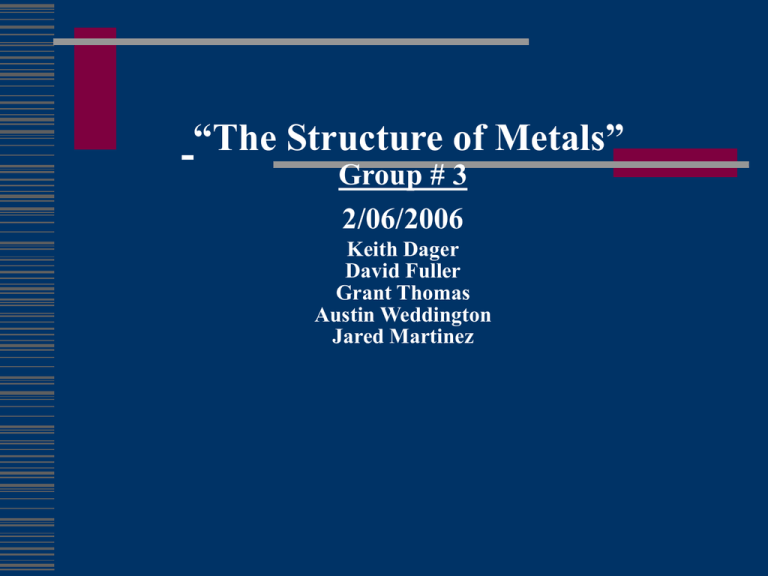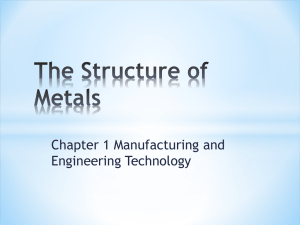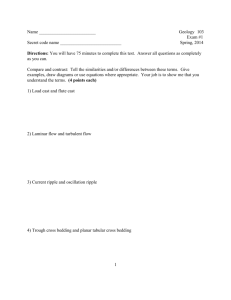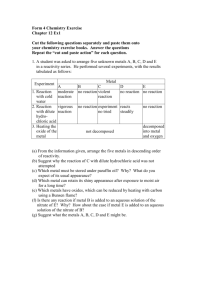“The Structure of Metals” Group # 3 2/06/2006 Keith Dager David
advertisement

“The Structure of Metals” Group # 3 2/06/2006 Keith Dager David Fuller Grant Thomas Austin Weddington Jared Martinez Introduction Many questions about metal can be answered by knowing their ATOMIC STRUCTURE (the arrangement of the atoms within the metals). The Crystal Structure of Metals Metals and Crystals What determines the strength of a specific metal. Three basic atomic arrangements 1of 3 basic atomic arrangements 1. Body-centered cubic (bcc) 1. A portion of the structure of a body-centered cubic metal (b.c.c.) 2 of 3 basic atomic arrangements 2. Face-centered cubic (fcc) also known as Cubic close packing 3 of 3 basic atomic arrangements 3. Hexagonal close-packed (hcp) Review of the three basic Atomic Structures B.C.C. F.C.C H.C.P Basic terminology Hard-ball / Hard-sphere - the small spheres used to display the unit cell and show the individual atomic arrangement. Basal planes- This is the orientation/layout of the atomic arrangement specifically in the h.c.p. layout of the ABAB pattern. Alloying- this is formed by adding atoms of one metal/metals to some other metal/metals. Allotropism/Polymorphism (meaning many shapes)- the appearance of more than one type of crystals. When a single crystal is subjected to an external force, it goes through Elastic Deformation If the force on the crystal is increased sufficiently, the crystal goes through Plastic/Permanent Deformation The amount of stress required for a crystal to permanently deform is the called the Critical Shear Stress Cross-Section F2 Shear Stress is the ratio of the applied shearing force to the cross-sectional area being sheared When this occurs, one plane of atoms slips across an adjacent plane of atoms F1 Tensile Force2 Tensile Force1 Video here b/a ratio – Proportional to the amount of shear stress needed to cause slip in single crystals Atoms b is inversely proportional to the atomic density in the atomic plane a is the spacing of atomic planes Anisotropic – The different properties of a single crystal when tested in different directions Examples : Plywood & Cloth Twinning – The crystal forms a mirror image of itself across the plane of twinning Tensile Force1 Tensile Force2 A slip system is the combination of a slip plane and its direction of slip Body-Centered Cubic structure 48 slip systems Highly probable for any shear stress to act on one of these systems, but because of a high b/a ratio, the shear stress required must be high Metals with these structures have good strength and moderate ductility (flexibility) Face-Centered Cubic structure 12 slip systems Moderate probability for a shear stress to act on one of these systems Low b/a ratio, the shear stress required is low Metals with these structures have moderate strength and good ductility Hexagonal Close-Packed structure 3 slip systems Low probability for a shear stress to act on one of these systems More systems become active at elevated temperatures Metals with these structures are usually brittle at room temperature The actual strengths of metals are lower than theoretical calculations because of defects and imperfections in crystal structures This includes: Grain/Phase Boundaries (Next Section) Volume/Bulk Imperfections Voids, Cracks, Inclusions ( nonmetallic elements) Point Defect Dislocations Vacancy - a missing atom Interstitial Atom - an extra atom in the structure Impurity – a foreign atom that has replaced an atom of metal Dislocations are defects in the orderly arrangement of the atomic structure including: Screw Dislocations Edge Dislocations Dislocations can lower the required shear stress to cause slip They can also interfere with each other and be impeded by barriers ( grain boundaries, impurities, inclusions ) which can cause the required shear stress for slip to go up. This is referred to as Work/Strain Hardening Increases strength of metal Increases hardness of metal Grains and Grain Boundaries and their effects on a metal Grain size has a significant effect on the strength of metals. Grain boundaries have a major influence on metal behavior. What are grains? Grains- individual, randomly oriented crystals within a metal Grain Structure of metal alloys How are grains formed? Molten metal begins to solidify Crystals begin to form independently of each other Each crystal has random unrelated orientation to the other Each of these crystals grows into a crystalline structure (a grain) What difference does Grain Size make? Significantly influences mechanical properties of the metal Large grain size is generally associated with - Low strength - Low hardness - Low ductility (extent of deformation before fracture) Small grain size is generally the opposite What determines Grain size? Three factors that influence the median size of developed grains • Rate of nucleation (initial rate of formation of the individual crystals) • Number of sites where crystals begin to form • Rate crystals grow Calcite crystal (~50 µm) grown at T = 800 °C and p = 300 MPa within 10 hours What determines Grain number? High rate of nucleation (comparatively) - Number of grains per unit volume of metal will be high - Grain size will be small High growth rate (comparatively) - Fewer grains per unit volume of metal - Grain size will be large Wear-resistant nanometals could make sporting goods more durable. The grain size of a nanocrystalline metal, right, is about 1,000 times smaller than conventional metal, above. When grain size is cut in half, the company says, hardness quadruples. Controlling grain size In general: Rapid cooling produces smaller grains. Slow cooling produces larger grains. The smaller the grain size, the stronger the metal How is grain size measured? 1. Counting the grains in a given area 2. Counting number of grains that intersect a length of a line (microscopic) 3. Determined by comparing to a standard chart (ASTM Chart) ASTM Chart American Society for Testing and Materials Grain number is determined by formula: N = 2^(n-1) N- Number of grains n- grain size number Per square inch at 100x magnification TABLE 1.1 ASTM No. –3 –2 –1 0 1 2 3 4 5 6 7 8 9 10 11 12 Grains/mm2 1 2 4 8 16 32 64 128 256 512 1,024 2,048 4,096 8,200 16,400 32,800 Grains/mm3 0.7 2 5.6 16 45 128 360 1,020 2,900 8,200 23,000 65,000 185,000 520,000 1,500,000 4,200,000 Examples of grain size Grain sizes between 5 and 8 are generally considered fine grains Grain size of 7 is acceptable for sheet metal of car bodies, kitchen utensils, and appliances Grain size can also be so large as to be seen with the naked eye as in zinc on the surface of galvanized sheet steels What are grain boundaries? Surfaces that separate individual grains 1. Influence strain hardening (boundaries interfere with the movement of dislocations) 2. More reactive than the grains themselves (atoms along grain boundaries are more disordered and packed less efficiently) 3. Great influence on the strength and ductility of the metal Cast Iron grain boundaries What can happen at grain boundaries? 1. Grain boundary sliding 2. Grain boundary embrittlement 3. Hot shortness Grain boundary sliding Process by which grains will begin to slide along one another at the boundary Possible Effects on Metal: 1. 2. Plastic deformation Creep mechanism (elongation under stress over period of time) Note: These types of deformation are usually accompanied with high temperatures as well Illustration of Creep Mechanism Grain Boundary embrittlement Generally: weakening of the grain boundaries by embrittling elements 1. 2. 3. Liquid-metal embrittlement (elements are in liquid state) Solid-Metal embrittlement (elements are in the solid state) Temper embrittlement (in alloy steels -caused by segregation (movement) of impurities to grain boundaries) Hot Shortness Generally: softening and/ or melting of metal along grain boundaries Cause: local melting of impurity in the boundary at a temperature below the melting point of the metal itself Effect: when subjected to plastic deformation at elevated temperatures, (hot working) the piece of metal crumbles and disintegrates along the metal boundary Prevention: metal is worked at a lower temperature Plastic Deformation of Polycrystalline Metals Polycrystalline Metals Equiaxed grains Plastic deformation Strain (deformation) Anisotropy Preferred Orientation Mechanical Fibering Polycrystalline metals What is Plastic Deformation of Polycrystalline Metals and all that goes with it? polycrystalline materials: metals, alloys, intermetallic compounds, ceramic materials, compound materials, polymers, semiconductors, nanocrystals, supraconductors, rocks; •Metals commonly used in manufacturing various products Consist of many individual, randomly oriented crystals (grains); Thus, metal structures typically are not single crystals but Polycrystals. (“many crystals”) •The most natural and artificial solids (rocks, ceramics, metal alloys or polymers) are polycrystalline. They contain many crystallites of different size, shape and different orientations. Equiaxed grains •Equiaxed grains •Having equal dimensions in all Directions, as shown in the in Fig.1.12a Reduction operation resulting in directionality or anisotropy Grain Sizes Equiaxed grains (having equal dimensions in all Directions, as shown in the in Fig.1.12a) TABLE 1.1 ASTM No. –3 –2 –1 0 1 2 3 4 5 6 7 8 9 10 11 12 Grains/mm2 1 2 4 8 16 32 64 128 256 512 1,024 2,048 4,096 8,200 16,400 32,800 Grains/mm3 0.7 2 5.6 16 45 128 360 1,020 2,900 8,200 23,000 65,000 185,000 520,000 1,500,000 4,200,000 Cold Working If a polycrystalline metal with uniform equiaxed grains is subjected to plastic deformation at room temperature(cold working), the grains become deformed and elongated. Homologous Temperature Ranges for Various Processes TABLE 1.2 Process Cold working Warm working Hot working T/Tm < 0.3 0.3 to 0.5 > 0.6 Deformation Process Compressing the metal: Compression stresses develop within a material when forces compress or crush the material. A column that supports an overhead beam is in compression, and the internal stresses that develop within the column are compression. As is done in forging to make a turbine disk "Stretching" Stretching is a process where sheet metal is clamped around its edges and stretched over a die or form block. This process is mainly used for the manufacture of aircraft wings, automotive door and window panels. As is done in stretching sheet metal to make a car body. Compressing and stretching (Turbine Disk and Car Body) Types of compressions and strains ANISOTROPY (Texture) As result of Plastic deformation, the grains have elongated in one direction and contracted in the other. Consequently, this piece of metal has become anisotropic. Anisotropic surface will change in appearance as it is rotated about its geometric normal, as is the case with velvet. anisotropic properties: plasticity, elasticity, hardness, strength, cleavability, thermal expansion and conductivity, electric conductivity, magnetization, corrosion resistance, optical properties. ANISOTROPY Texture and Anisotropy of Crystalline Materials A crystal is characterized by the periodic arrangement of its elements (atoms, ions) in space. This always generates a dependence of the crystal properties on the chosen direction, which is called anisotropy. Thus, the modulus of elasticity can vary by the factor 22 in a graphite crystal depending on the direction. Anisotrop y (b) Figure 1.13 (a) Schematic illustration of a crack in sheet metal that has been subjected to bulging (caused by, for example, pushing a steel ball against the sheet). Note the orientation of the crack with respect to the rolling direction of the sheet; this sheet is anisotropic. (b) Aluminum sheet with a crack (vertical dark line at the center) developed in a bulge test; the rolling direction of the sheet was vertical. Source: J.S. Kallend, Illinois Institute of Technology. Anisotropy The most important parameter describing the anisotropy of polycrystalline materials is their texture. Via the anisotropy of physical properties due to the lattice structure, a regular texture in which the crystallites of one phase have only a few preferred orientations produces anisotropy of the polycrystalline material as well. . Anisotropy In a single crystal, the physical and mechanical properties often differ with orientation. It can be seen from looking at our models of crystalline structure that atoms should be able to slip over one another or distort in relation to one another easier in some directions than others. When the properties of a material vary with different crystallographic orientations, the material is said to be anisotropic. Preferred Orientation Also called crystallographic anisotropy can best be described by referring to fig. 1.6a.When a metal crystal is subjected to tension, the sliding blocks rotate the direction of the pulling force direction. Note:for polycrystalline with grains in random orientation, all slip directions tend to align themselves with the direction of the pulling force while slip planes under compression tend to align themselves in a direction perpendicular to the direction of the compressing force. Preferred Orientation 1.12 Equiaxed grains (having equal dimensions in all Directions, as shown in the in Fig.1.12a) (equiaxed) grains in a specimen subjected to compression (such as occurs Figure 1.12 Plastic deformation of idealized in the rolling or forging of metals): (a) before deformation; and (b) after deformation. Note hte alignment of grain boundaries along a horizontal direction; this effect is known as preferred orientation. Mechanical Fibering This type of anisotropy results from the alignment of inclusions (stringers), impurities and voids in the metal during •Inclusions (Stringers)- Usually non-metallic particles deformations. contained in metal. In steel they may consist of simple or complex oxides, sulphides, silicates and sometimes nitrides of iron, maganese, silicon, aluminium and other elements. In general they are detrimental to mechanical properties buy much depends on the number, their size, shape and distribution. Mechanical Fibering impurity effects on metals (graph explanation) The first model proposed that elements that draw charge from the neighbouring metal–metal bonds weaken them and embrittle the materials1,2. The second model states that the tendency to embrittlement is determined by whether the impurity is more likely to segregate to a grain boundary or a surface3,4.The model suggests that this parameter predicts the relative likelihood of forming a sharp crack (brittle fracture) over a blunt crack (as in a tough material).Using this criterion, the segregation data of Miolinari et al.5 would predict that Bi would not embrittle Cu. The third model states that embrittlement occurs when impurities segregate to the grain boundaries and make Effects of impurities (graphs) 1 3 2 Perfect analogy: Mechanical fibering Major consequence: If the spherical grains in fig 1.12a were coated with impurities, these impurities would align themselves generally in a horizontal direction after deformation. Because impurities weaken the grain boundaries. This piece of metal will be weak and less ductile when tested in the vertical direction. Such as a plywood. Recovery, Recrystallization, Grain Growth Recovery: The removal of residual stresses by localized plastic flow as the result of low-temperature annealing operations. Recrystallization: The change from one crystal structure to another, as occurs on heating or cooling through a critical temperature. Grain Growth: The enlarging or coarsening of the individual grains within the metal or alloy during heating at a temperature above the recrystalization temperature. Cold, Hot and Warm Working Cold Work Altering the shape or size of a metal by plastic deformation. it is carried out below the recrystallisation point usually at room temperature Methods of cold working Processes include rolling, drawing, pressing, spinning, and peening Effects of cold work Increased Strength Increased Hardness Decreased Malleability Decreased Ductility Hot Working The rolling, forging or extruding of a metal at a temperature above its recrystallisation point. Method of Hot work Rolling, Pressing, Forging Quenching Effects of Hot Work Undesirable surface finish Less force required than cold work Decreased yield strength Warm Working warm working: is carried out at intermediate temperatures. It is a compromise between cold and hot working. Effects of Warm Working The effects of this type of working depend on how close is the warm process to be a cold or hot process. The type of process chosen depends on the physical and mechanical properties needed for the product, meaning the product itself and its uses. Annealing Annealing consists of: (1) recovery (stressrelief ), (2) recrystallization, (3) grain growth Annealing reduces the hardness, yield strength and tensile strength of the steel. The benefits of annealing are: Improved ductility Removal of residual stresses that result from cold-working or machining Improved machinability Grain refinement A Real World Application Conclusions 1. The terms cold, warm and hot working are relative. The difference between them is the temperature at which the process is carried out. 2. There is not a “best” process. It all depends on what will be the use of the product, or what is the product going to be. Definitions Quenching: Rapid cooling from a high temperature by immersion in a liquid bath of oil or water. Used to harden metal. Hardness: is the characteristic of a solid material permanently without breaking or rupturing Ductility: is the physical property of being capable of sustaining large plastic deformation without fracture Peening: is the mechanical working of metals by means of hammer blows or by blasting with shot Malleability: is the property that enables a material to deform by co mpressive forces without developing defects Tensile strength: measures the force required to pull something such as rope, wire, or a structural beam to the point where it breaks Brittleness: is the opposite of the property of plastic- ity. A brittle metal is one that breaks or shatters before it deforms Brittleness is the opposite of the property of plastic- ity. A brittle metal is one that breaks or shatters before it deforms expressing its resistance to permanent deformation Plasticity: is the ability of a material to deform Annealing: is the process by which the distorted cold worked lattice structure is changed back to one which is strain free through the application of heat. Glossary Ductility the property of a metal which allows it to be permanently deformed, in tension, before final rupture. •Elasticity •The property which enables a material to return to its original shape and dime •Fatigue Strength •the unit stress that ruptures a bar after an enormous (around 40 million) num •repetitions of a load covering a range of values. •Rolling •The process of shaping metals by passing it between rolls revolving at the same peripheral speed and in opposite directions. References http://www.nd.edu/~manufact/figures.html http://en.wikipedia.org http://info.lu.farmingdale.edu/depts/met/met20 5/annealingstages.html http://www.principalmetals.com/glossary/rdoc. htm info.lu.farmingdale.edu/.../ met205/coldwork.html http://tech.clayton.edu/eddins/hotworki.htm http://www.seas.upenn.edu/~chem101/ssc hem/metallicsolids.html Work cited •http://www.ndted.org/EducationResources/CommunityCollege/Materials/Structure/anisotropy. htm http://www.tpub.com/steelworker1/2.htm Questions





